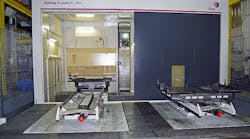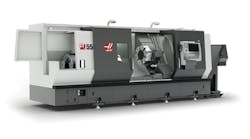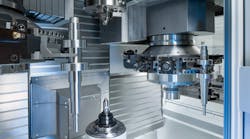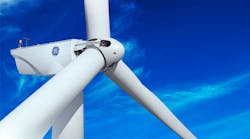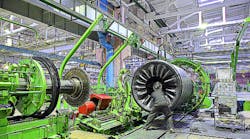Boring Mill Generating Excitement for Shop with Energy-Sector Expansion Plans
Milwaukee Machine Works manufactures large-scale, critical-tolerance machined parts and assemblies, but it is increasing its part capacity and expanding its energy-sector business thanks to a dual-pallet Giddings & Lewis MC 1600 horizontal boring mill (HBM) from Fives. The rotary table HBM, designed for multi-axis contour milling, precision boring, drilling and tapping, was installed during the spring at the 80,000-sq.ft. plant in Wisconsin. Plans call for it to produce a variety of large-dimension parts, some as long as 10 ft (3 m) and weighing as much as 7,000 lbs. (3,175 kg), including wind turbine gearbox housings and fluid end-manifolds for the oil-and-gas industry.
According to the developer, Fives’ Giddings & Lewis MC Series brings machining center capabilities to horizontal boring mills for automated large-part production. “Our primary business is large parts — some with more than 300 machined features — so the new boring mill not only expands our part capacity, it also boosts our efficiency with pallet changing and machining center capabilities,” Millwaukee Machine Works general manager Mike Manna, explained.
“Meeting tight tolerances is a concern as well,” he continued. “We typically hold bore-to-bore centerline, perpendicularity and parallel tolerances of 0.001 to 0.002 in. (0.0254 - 0.0508 mm) over 20 to 30 in. (0.508 - 0.762 m), and we expect this machine to hold this over the entire range of travel — even as our parts get larger. The extra capacity will allow us to expand our business, and the machine’s advanced features allow us to increase our efficiency.”
Milwaukee Machine Works is an ISO 9001:2008-certified machine shop that produces parts for OEMs in the agricultural, oil-and-gas, construction/mining, and wind-energy industries, offering value-added assembly as well as machining. Among its product capabilities are gearbox housings, planetary carriers, axles, and powertrain components.
High Spindle Utilization
The MC 1600’s dual 63.0 x 63.0 in. (1600 x 1600 mm) pallet shuttle system ensures high spindle utilization, and robust one-piece cast iron column base and bed provide a rigid machining platform to handle heavy cuts in hard materials. The column is X-braced to enhance structural integrity, resist deflection and minimize vibration.
Feed thrust in all three linear axes is 6,744 lbs (30,000 N). A built-in 360,000 position contouring rotary table with programmable mechanical clamp handles parts to 55,000 pounds (25,000 kg), allowing precision 4-axis machining on a variety of part geometries. Modular design allowed MMW to custom-configure the machine with a four-speed, 3,500-rpm/56-kW (76 hp) spindle, and 120-tool magazine.
The oil-lubrication in the air-through spindle feature automatically lubes the rotary coupling when air through the spindle is used, extending the machining periods.
The MC 1600 includes the Giddings & Lewis Adaptive Control and Spindle Load monitoring software packages to help reduce tool breakage and/or spindle damage in high-feed milling operations on tough material, such as the cast iron and 4340 steel, often machined at MMW. The Adaptive Control feature is easy to use, and adjusts the feed-rate between programmed minimum and maximum values. It compensates for changes in cutting conditions, such as depth of cut and material hardness, to maintain the desired cutting horsepower.
Adaptive Control also can be used to enhance the machine's productivity by allowing more aggressive feeds to be programmed.
Spindle Load monitoring software provides a simple operator interface and application for the operator to set acceptance values for spindle load trip points to be used in subsequent cutting operations. The operator/programmer uses M-codes to activate and deactivate load monitoring. The monitor uses either the Fanuc tool-retract feature, or “feed hold” when the spindle load trip point is exceeded.
According to Mike Manna, MMW went through an extensive evaluation of available machines before selecting the MC 1600, comparing it against six other machines on a matrix of more than 20 features and benefits.
“When compared to the other machines on our list, we found the MC 1600 more technologically advanced,” he recalled. “And, that’s important because our wind gearbox customers are continually tightening tolerances as they look to extend the life of parts.
“We also have a G&L MC 1250, on which we run our most critical tolerance parts,” Manna said, ?and it has an excellent performance history. The features and design of the two machines are very similar, so our operators will have a very short learning curve.”
